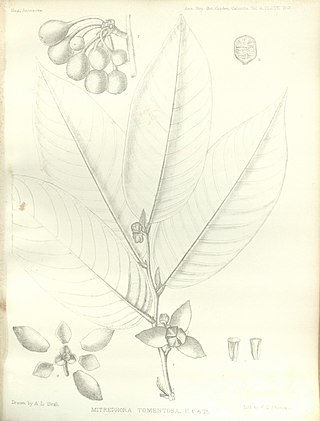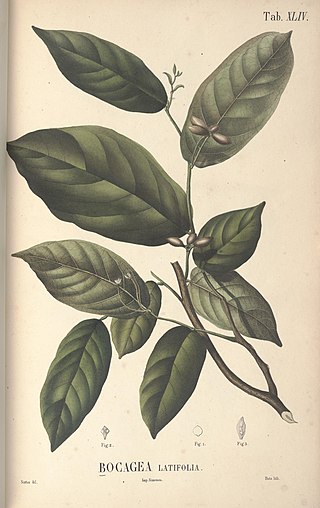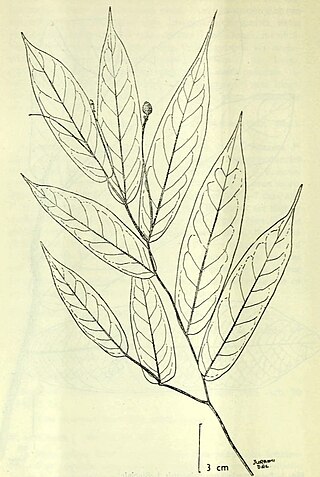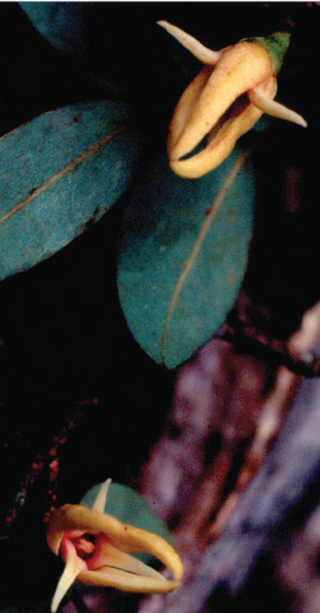Asteranthe asterias is a species of plant in the family Annonaceae. It is native to Kenya and Tanzania. Spencer Le Marchant Moore, the English botanist who first formally described the species using the basionym Uvaria asterias, did not explicitly explain the epithet, but was likely referencing the star-like appearance of its flower’s petals.
Hexalobus bussei is a species of plant in the family Annonaceae. It is native to Cameroon. Ludwig Diels, the German botanist who first formally described the species, named it after another German botanist, Walter Busse, who collected the sample that Diels examined.

Mitrephora keithii is a species of plant in the family Annonaceae. It is native to Myanmar, Peninsular Malaysia and Thailand. Henry Nicholas Ridley, the English botanist who first formally described the species, named it in honor of Dr. A. Keith who collected the sample that Ridley examined.
Mitrephora calcarea is a species of plant in the family Annonaceae. It is native to Laos and Vietnam. Aruna Weerasooriya and Richard M.K. Saunders, the botanists who provided the first valid formal description of the species, named it after the limy soil it grows in. The name follows a prior invalid account by Suzanne Jovet-Ast, which lacked a Latin description.

Mitrephora tomentosa is a species of plant in the family Annonaceae. It is native to Bangladesh, Cambodia, Laos, Myanmar, Thailand, and Vietnam. Joseph Hooker and Thomas Thomson, the British botanists who first formally described the species, named it after the dense covering of hair on its young branches, leaves and flowers.

Neostenanthera gabonensis is a species of plant in the family Annonaceae. It is native to Cabinda Province, Cameroon, Equatorial Guinea, Gabon, Ghana, Ivory Coast, Liberia, and The Republic of the Congo. Heinrich Gustav Adolf Engler and Ludwig Diels, the German botanists who first formally described the species, using the basionym Oxymitra gabonensis, named it after Gabon where the specimen they examined was found near a site they identified as Sibange-Farm.
Pseuduvaria dielsiana is a species of plant in the family Annonaceae. It is native to New Guinea. Carl Lauterbach, the German botanist who first formally described the species using the synonym Goniothalamus dielsianus, named it in honor of Ludwig Diels, another German botanist who also worked on taxa from New Guinea.
Pseuduvaria kingiana is a species of plant in the family Annonaceae. It is native to the Malay Peninsula. Yvonne Chuan Fang Su and Richard Saunders, the botanists who first formally described the species, named it after Sir George King, the British botanist who first collected the species.

Pseuduvaria latifolia is a species of plant in the family Annonaceae. It is native to Java. Carl Ludwig Blume, the German botanists who first formally described the species using the synonym Bocagea latifolia, named it after its broad leaves.

Pseuduvaria macrocarpa is a species of plant in the family Annonaceae. It is native to The Maluku Islands and New Guinea. William Burck, the Dutch botanist who first formally described the species using the synonym Meiogyne macrocarpa, named it after its large fruit.
Pseuduvaria mindorensis is a species of plant in the family Annonaceae. It is native to the Philippines. Yvonne Su and Richard Saunders, the botanists who first formally described the species, named it after the island of Mindoro where the specimen they examined was collected in the municipality of Puerto Galera.

Pseuduvaria guineensis is a species of plant in the family Annonaceae. It is native to New Guinea. James Sinclair, the Scottish botanist who first formally described the species, named it after New Guinea where the specimen he examined was collected near Kokoda.

Pseuduvaria pamattonis is a species of plant in the family Annonaceae. It is native to Borneo and the Philippines. Friedrich Miquel, the Dutch botanist who first formally described the species using the basionym Orophea pamattonis, named it after a mountain in Borneo called Gunung Pamaton.
Pseuduvaria parvipetala is a species of plant in the family Annonaceae. It is native to Borneo and Sumatra. Yvonne Su and Richard Saunders, the botanists who first formally described the species, named it after its small petals.

Pseuduvaria reticulata is a species of plant in the family Annonaceae. It is native to Bangladesh, Borneo, Java, the Lesser Sunda Islands, Myanmar and Sumatra. Carl Ludwig Blume, the botanist who first formally described the species under the basionym Uvaria reticulata, named it after the net-like pattern of veins on the underside of its leaves.

Pseuduvaria sessilifolia is a species of plant in the family Annonaceae. It is native to New Guinea. James Sinclair, the botanist who first formally described the species, named it after its stalkless leaves which lack petioles.

Pseuduvaria villosa is a species of plant in the family Annonaceae. It is endemic to Australia. L.W. Jessup, the botanist who first formally described the species, named it after its leaves and branchlets which are shaggy with long soft hairs.

Uvariastrum hexaloboides is a species of plant in the Annonaceae family. It is native to Tanzania, Zambia and Zaire. Robert Elias Fries, the botanist who first formally described the species using the basionym Uvaria hexaloboides, named it after a different species Hexalobus monopetalus which he thought its flowers and vegetative parts resembled.

Uvariastrum pierreanum is a species of plant in the Annonaceae family. It is native to Cameroon, the Central African Republic, the Democratic Republic of the Congo, Equatorial Guinea, Gabon, Ghana, Guinea, the Ivory Coast, Liberia, Nigeria, Sierra Leone and the Republic of the Congo. Adolf Engler, the botanist who first formally described the species, named it after the French botanist Jean Baptiste Louis Pierre.

Xylopia arenaria is a species of plant in the Annonaceae family. It is native to Kenya, and Tanzania. Adolf Engler, the botanist who first formally described the species, named it after its growth in sandy places.














